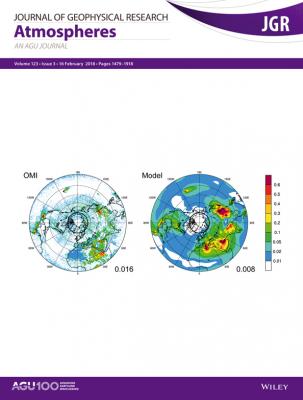Sulfate Aerosol in the Arctic: Source Attribution and Radiative Forcing
Long-range transport of aerosols from mid-latitudes in the Northern Hemisphere can increase aerosol concentrations in the Arctic. Depending on the source, these aerosols perturb the Arctic energy balance by absorbing or scattering energy, heating or cooling the atmosphere and surface. Scientists at the U.S. Department of Energy’s Pacific Northwest National Laboratory analyzed 16 source regions or sectors of sulfate aerosols to determine how much influence each individual source exerts on energy balance in the Arctic.
Researchers found that meteorology drives the seasonality of contributions to Arctic sulfate concentrations from remote sources, and cooling from sulfates can partially offset Arctic warming from absorbing aerosols, such as black carbon. Knowing the source of sulfate in the Arctic and its contribution to energy balance is important for understanding Arctic climate change.
Sulfate compounds (commonly called sulfate) are produced by power plants and industrial processes, and are also found in nature. These aerosols can affect Earth’s energy balance by scattering heat from the sun. To quantify these interactions and their influence on Arctic climate, researchers performed simulations using the Community Earth System Model equipped with an explicit sulfur source tagging technique, time-varying sulfur dioxide emissions, and meteorological conditions for the time period of 2010−2014. They found that regions with high emissions and/or are near or within the Arctic presented relatively large contributions to Arctic sulfate burden. The largest contribution came from sources in East Asia (27 percent).
Researchers also found that meteorology strongly influenced seasonal variations in the contribution to Arctic sulfate concentrations from remote sources. The mean cooling effect on energy balance from sulfate aerosols offsets the positive top-of-the-atmosphere warming effect from black carbon in the atmosphere by one-third. A 20 percent global reduction in sulfur dioxide emissions led to a net Arctic top-of-the-atmosphere warming of 0.02 W m-2. These findings suggest that jointly reducing future black carbon and sulfur dioxide emissions could prevent at least some of the Arctic warming that would result from reductions in sulfur dioxide emissions alone. Calculations also indicate that sources with shorter transport pathways and meteorology favoring longer aerosol lifetimes are more efficient in influencing the Arctic energy balance changes. This study concluded that current sulfur emissions would result in an equilibrium Arctic cooling of about –0.19 K, with –0.05 K of that from sources in East Asia.

